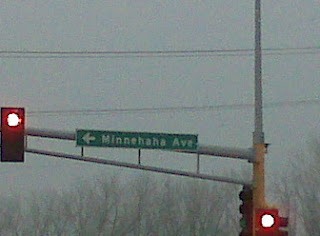Did it snow in San Francisco? Nope! Jennie took me on a little trip for work to Minneapolis - the largest city in the state of Minnesota. The city lies on both banks of the Mississippi River, just north of the river's confluence with the Minnesota River, and adjoins Saint Paul, the state's capital. Known as the Twin Cities, these two cities form the core of Minneapolis-St. Paul, the fifteenth largest metropolitan area in the United States, with about 3.5 million residents. The U.S. Census Bureau estimated the population of the city of Minneapolis at 372,811 people in 2005.
Abundantly rich in water, the city has twenty lakes and wetlands, the Mississippi riverfront, creeks and waterfalls, many connected by parkways in the Chain of Lakes and the Grand Rounds Scenic Byway. Once the world's flour milling capital and a hub for timber, Minneapolis is the primary business center between Chicago, Illinois, and Seattle, Washington. The name Minneapolis is attributed to the city's first schoolmaster, who combined mni, the Dakota word for water, and polis, the Greek word for city. Minneapolis is nicknamed the City of Lakes and the Mill City.
Minnehaha is a fictional Native American woman documented in Henry Wadsworth Longfellow's 1855 epic poem The Song of Hiawatha. She is the lover of the titular protagonist Hiawatha. The name is often incorrectly said to mean "laughing water", though in reality it translates to "waterfall" in Dakota. Her name is connected to many things in Minnesota, such as Minnehaha Falls, Minnehaha Park, Minnehaha Creek, Minnehaha Academy, and the name of a boat once operated by Twin City Rapid Transit on Lake Minnetonka, which has now been restored, and is now at the Museum of Lake Minnetonka. Minnehaha Avenue and Hiawatha Avenue are both major thoroughfares that run parallel to each other, heading southeast from downtown Minneapolis.
Jennie was in Minneapolis to visit the city's Veteran's Affairs Medical Center. The Department of Veterans Affairs (VA) was established on March 15, 1989, succeeding the Veterans Administration. It is responsible for providing federal benefits to veterans and their families. Headed by the Secretary of Veterans Affairs, VA is the second largest of the 15 Cabinet departments and operates nationwide programs for health care, financial assistance and burial benefits. Perhaps the most visible of all VA benefits and services is health care. From 54 hospitals in 1930, VA’s health care system now includes 155 medical centers, with at least one in each state, Puerto Rico and the District of Columbia. VA operates more than 1,400 sites of care, including 872 ambulatory care and community-based outpatient clinics, 135 nursing homes, 45 residential rehabilitation treatment programs, 209 Veterans Centers and 108 comprehensive home-care programs. VA health care facilities provide a broad spectrum of medical, surgical and rehabilitative care. Almost 5.5 million people received care in VA health care facilities in 2006. By the end of fiscal year 2006, 78 percent of all disabled and low-income veterans had enrolled with VA for health care; 65 percent of them were treated by VA. In 2006, VA inpatient facilities treated 773,600 patients. VA’s outpatient clinics registered over 60 million visits.
My next post will be my last - as I am on my way back home - with TREASURE! More on that on my final post.




No comments:
Post a Comment